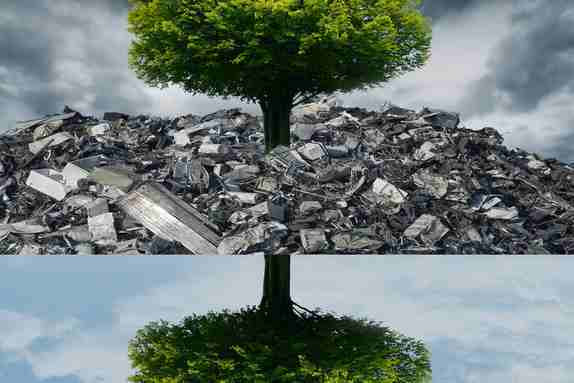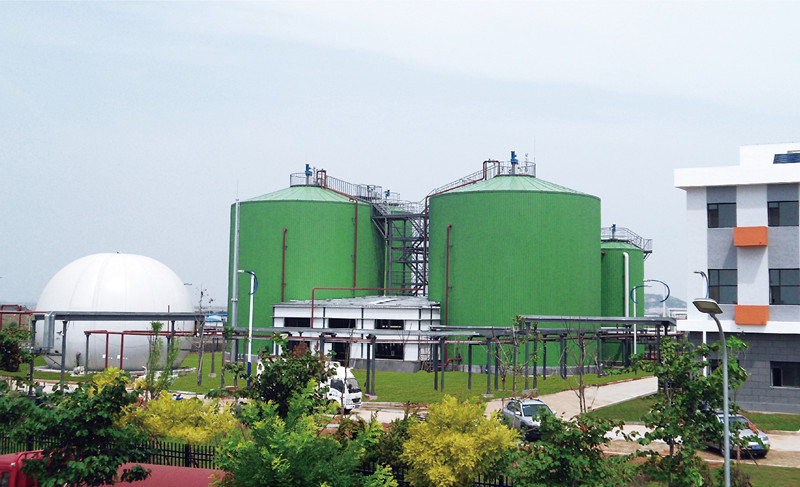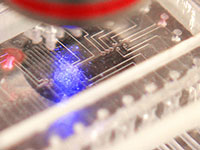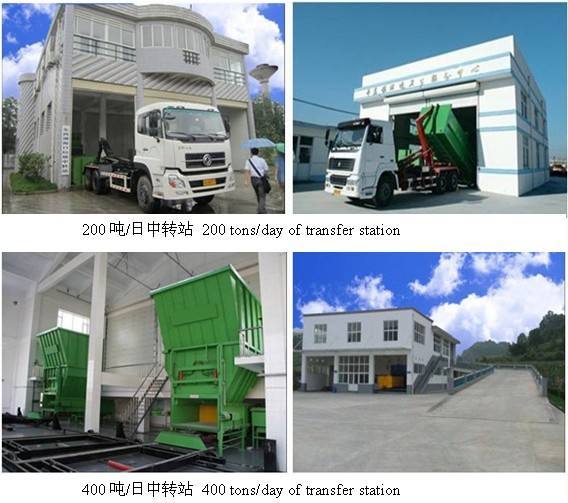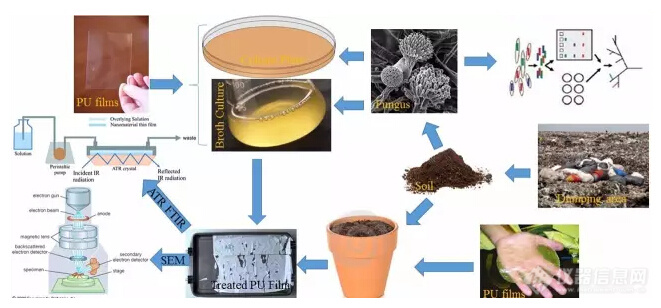中国科学家在垃圾堆中发现吃塑料的真菌
p 塑料是工业文明的产物,塑料的合成大大提高了我们的生活质量。我们人类正在生产着大量的塑料,其中大部分最终成为垃圾。塑料废弃物通过阻塞水路和污染土壤,释放有害物质,甚至对动物造成威胁,这些动物会把塑料碎片误认为食物。中国科学院昆明植物研究所的科学家们最近发现并鉴定出一种真菌,其可以通过使用酶快速分解塑料,从而帮助解决我们环境中的塑料污染问题。 /p p 在人类工业化合成塑料之前,塑料聚合物在自然界并不存在,因此塑料不容易被细菌、真菌和其它生物所降解。塑料的生物降解是全球环境污染研究的热点和难点。全球科学家在上个世纪九十年代就开始研究塑料的生物降解,先后发现了几十种具有降解塑料的真菌,但是由于其降解效率低、降解不彻底而作罢。这次昆明植物所许建初研究团队首次发现了能够高效降解聚氨酯(PU)塑料的新菌种,是近几年来科学家在塑料生物降解领域的重大突破。 /p p 中科院昆明植物研究所许建初研究团队从垃圾堆中发现吃塑料的真菌——一种了不起眼的土壤小型真菌。该真菌首先是来自巴基斯坦的Sehroon Khan博士从伊斯兰堡一处垃圾处理场土壤中分离出来的。研究团队在实验室发现它可以在塑料表面生长,并通过生长过程中产生的酶和塑料发生生物反应,破坏塑料分子间或聚合物间的化学键。研究团队中来自斯里兰卡的Samantha Karunarathna博士把该真菌鉴定命名为塔宾曲霉菌(Aspergillus tubingensis)。 /p p 研究团队发现在自然环境中的难以降解的塑料,在塔宾曲霉菌作用下两周就可以明显看到生物降解过程,两个月后其培养基上的塑料聚合物基本消失。 /p p /p p style=" text-align: center" img src=" http://img1.17img.cn/17img/images/201704/insimg/e35c7ffc-efe8-475e-95d1-bfab01f76830.jpg" title=" 1.jpg" style=" width: 561px height: 261px " vspace=" 0" hspace=" 0" height=" 261" border=" 0" width=" 561" / /p p style=" text-align: center " strong span style=" color: rgb(0, 176, 240) " 塔宾曲霉菌对聚氨基甲酸酯的降解过程 /span /strong /p p 曲霉真菌和人类合成的塑料聚合物相生相克的关系也为土壤污染处理和生态修复提供了新的线索。该研究为处理塑料垃圾开辟了新途径,例如在垃圾填埋场喷洒生物降解的真菌剂可以大大加速垃圾中塑料聚合物的降解速度和效率。据科学家估计,全世界为人类认识并科学描述的真菌不到其总数的10%,这意味着仍有大量潜在有用的真菌可被发现。可惜的是自然界中包括热带雨林中许多物种在没有被科学描述之前就消失了。我们可能会越来越依赖在人造环境里寻找那些物种,更多的科学家可能会尴尬地发现是在人类自己产生的垃圾场进行研究,而不是在热带雨林之中。 /p p style=" text-align: center" img src=" http://img1.17img.cn/17img/images/201704/insimg/3cacf9c4-a9bd-4787-8058-c5564da84faa.jpg" title=" 2.jpg" style=" width: 541px height: 404px " vspace=" 0" hspace=" 0" height=" 404" border=" 0" width=" 541" / /p p style=" text-align: center " span style=" color: rgb(0, 176, 240) " strong 多 /strong strong 个塔宾曲霉菌孢子 /strong /span /p p style=" text-align: center" img src=" http://img1.17img.cn/17img/images/201704/insimg/b34a72ab-68c2-4597-b513-c5144616fc0a.jpg" title=" 3.jpg" style=" width: 535px height: 405px " vspace=" 0" hspace=" 0" height=" 405" border=" 0" width=" 535" / /p p style=" text-align: center " strong span style=" color: rgb(0, 176, 240) " 塔宾曲霉菌孢子. Sehroon Khan /span /strong /p p style=" text-align: center" img src=" http://img1.17img.cn/17img/images/201704/insimg/efbea33a-7002-417f-94f3-785ac730640d.jpg" title=" 4.jpg" style=" width: 537px height: 404px " vspace=" 0" hspace=" 0" height=" 404" border=" 0" width=" 537" / /p p style=" text-align: center " strong span style=" color: rgb(0, 176, 240) " 塑料的电子显微镜照片,显示了由于真菌生长而引发的裂纹. Sehroon Khan /span /strong /p p style=" text-align: center" img src=" http://img1.17img.cn/17img/images/201704/insimg/a8730318-39a4-4a3c-b7ec-a4a956de2099.jpg" title=" 5.jpg" style=" width: 538px height: 405px " vspace=" 0" hspace=" 0" height=" 405" border=" 0" width=" 538" / /p p style=" text-align: center " strong span style=" color: rgb(0, 176, 240) " 废塑料通常最终会被堆放在垃圾填埋场里. Alan Levine_flickr /span /strong /p p style=" text-align: center" img src=" http://img1.17img.cn/17img/images/201704/insimg/5a9df19d-9348-4ed2-b8b6-39dde0ce1d47.jpg" title=" 6.jpg" style=" width: 537px height: 356px " vspace=" 0" hspace=" 0" height=" 356" border=" 0" width=" 537" / /p p style=" text-align: center " strong span style=" color: rgb(0, 176, 240) " 废塑料通常最终会被堆放在垃圾填埋场里. Justin Ritchie_flickr /span /strong /p p style=" text-align: center" img src=" http://img1.17img.cn/17img/images/201704/insimg/a112dd4e-1da2-436f-b648-368992666902.jpg" title=" 7.jpg" style=" width: 538px height: 376px " vspace=" 0" hspace=" 0" height=" 376" border=" 0" width=" 538" / /p p style=" text-align: center " span style=" color: rgb(0, 176, 240) " strong 洋流可将塑料带到远离其起源地的海岸线. Bo Eide_flickr /strong /span /p p style=" text-align: center" img src=" http://img1.17img.cn/17img/images/201704/insimg/bae8cc2d-1931-4173-bec7-47a2985036e6.jpg" title=" 8.jpg" style=" width: 538px height: 405px " vspace=" 0" hspace=" 0" height=" 405" border=" 0" width=" 538" / /p p style=" text-align: center " span style=" color: rgb(0, 176, 240) " strong 一块塑料,显示了其被黑色真菌生长而吞噬出的孔洞. Sehroon Khan /strong /span /p





